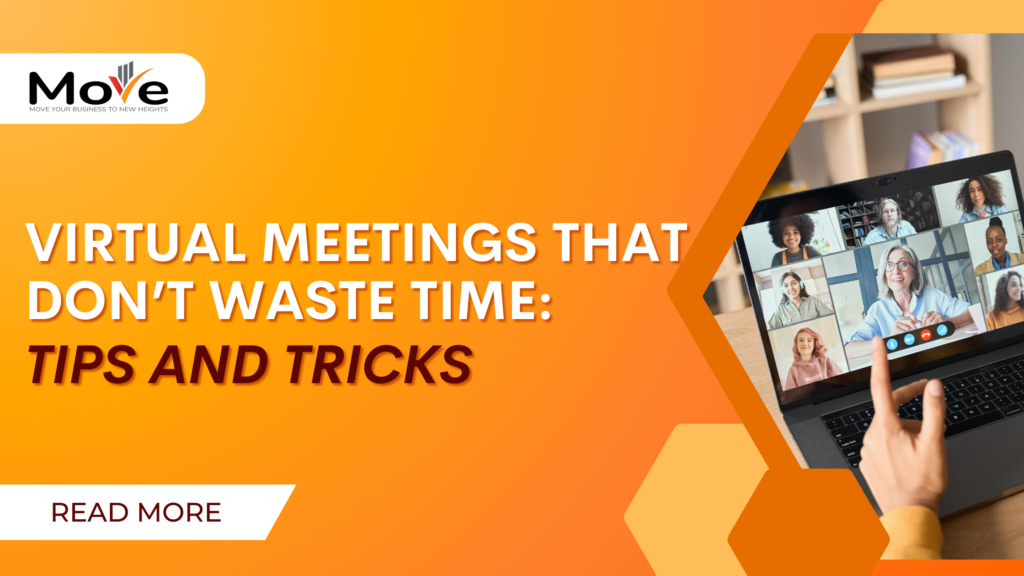Virtual meetings are the foundation of efficient communication and collaboration in the remote workspace. The ability to organize efficient virtual meetings is critical. Every minute you and your team spend unproductively is time wasted. In fact, research has found that 71% of those meetings might indeed be money down the drain.
The challenge, however, is to ensure that these sessions are efficient and do not squander valuable time. In this blog post, we’ll look at some ideas and methods to help you hold virtual meetings that stimulate collaboration, align objectives, successfully assign tasks, and complete action items without wasting time.

1. Establish Specific Goals
Every meeting should have a specific goal. A survey of 2,800 virtual employees revealed that setting these goals can lead to a more pleasant meeting. Before scheduling a virtual meeting, consider your objectives. Are you giving updates, generating ideas, making decisions, or delegating tasks? Communicate these goals to your team so that everyone is aware of the reason and can come prepared.

2. Send the Agenda Ahead
How can you keep your virtual employees engaged in a meeting? 64% of remote workers agree that a well-planned meeting is the best way to do this.
A well-organized agenda is the foundation of a fruitful meeting. Outline the topics to be discussed, allot time for each, and distribute the agenda ahead of time. This allows participants to prepare, which helps to keep the meeting on track and focused.
Ensure your agenda is sent 1-3 days ahead with all the necessary attachments participants need to read. A quick and simple example of an agenda might look like this:
- Welcome and Introduction (5 minutes)
- Review of Previous Meeting’s Action Items (3 minutes)
- Q4 December Marketing Campaign Brainstorming (15 minutes)
- Campaign Messaging and Tone (10 minutes)
- Channel Selection (10 minutes)
- Assigning Action Items and Deadlines (5 minutes)
- Wrap-up and Next Steps (2 minutes)

3. Choose the Most Effective Technology
Choose an efficient virtual meeting platform that meets your team’s needs. 89% of employees believe that the proper technology can help them enhance their meeting outcomes. Ensure that it includes crucial features such as video conferencing, screen sharing, chat, and the ability to record meetings. Before the meeting, familiarize yourself with the platform to troubleshoot technological concerns.
Platforms such as Zoom, Microsoft Teams, and Google Meet offer a wide range of virtual meeting services such as video conferencing, screen sharing, chat, and recording. Check that everyone has access to and is comfortable using the chosen platform.

4. Assign Roles
Appoint someone to lead and keep the meeting on track. To ensure that the meeting works successfully, assign tasks such as timekeeper, note-taker, and facilitator. This delegation allows you to concentrate on the content rather than the practicalities.
For a project kickoff meeting, you might assign roles as follows:
- Project Manager: This person oversees overall project coordination, creating schedules, and ensuring that all team members fulfill deadlines.
- Team Leader: This team member leads a sub-team or a specific component of the project and serves as the team’s point of contact.
- Subject Matter Expert (SME): This might be a person with specialized knowledge or a skill in a certain area needed in the project.
- Researchers: These members can conduct research, collect data, and synthesize information for projects.

5. Set a Time Limit
Respect the time of participants by sticking to a schedule. If you only have 30 minutes for the meeting, try to finish it in that time. Effective meetings foster trust and reflect your dedication to productivity. For example, if you set aside 30 minutes for the meeting, make sure you finish on time, even if it means scheduling a follow-up meeting to cover additional issues.

6. Encourage Participation
Encourage all attendees to participate actively. You can do this by asking open-ended questions, creating a poll, and integrating quieter team members to speak up. The meeting becomes more meaningful when everyone feels heard and valued.
You could try saying, “Let’s go around and hear everyone’s thoughts on this topic.” You may also use polling capabilities within your virtual meeting platform, like as Zoom’s poll function, to encourage participation.

7. Visual Aids and Documentation
Visual aids like slides or documents can help you illustrate key points. This is especially useful since 65% of the world processes visual input more easily than auditory input. It’s a good idea to share these materials before or during the meeting and refer to them as needed. After the meeting, provide access to meeting notes and action items to keep everyone informed and accountable.
Utilize platforms like Google Slides or Canva to create engaging visual presentations. Share the link to the presentation before the meeting or use screen sharing during the meeting to illustrate key points.

8. Limit Distractions
Interruptions to your mental load can lead to ineffective meetings. The most common distractions include checking emails and texting. Before the meeting, you can inform your members not to use their smartphones or other devices. They might have to turn off their notifications. In addition, everyone not speaking on your conference call will need to turn off their microphones.

9. Follow up with Action Items
At the end of the meeting, assign specific action items with deadlines. Document who is in charge of each task and promptly convey this information. Action item follow-up ensures that progress is achieved between meetings.
Dedicate time to assigning action items consciously utilizing a shared document (e.g., Google Docs) or project management tool (e.g., Trello). For example, you might say “Sarah will research potential advertising platforms and report back by next Monday.”

10. Improve and Evaluate
Take the time to assess the effectiveness of each virtual meeting. You can send a brief survey to participants asking for comments on how effective the meeting was. Collect participant input and identify opportunities for improvement. Utilize this feedback to improve your approach and make future meetings even more productive.

The Bottom Line
Remember that the purpose is to create results, not just conduct meetings. With these tips and methods, you can turn virtual meetings into effective instruments for communication, goal alignment, task assignment, and action item completion, eventually propelling your company to success.
Approach outsourcing with a reliable partner on your side with Managed Outsourced Virtual Employees or MOVE. Reach out to gain insights on your outsourcing journey.

